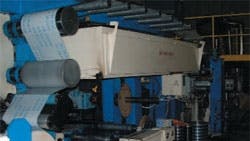Packaging Focus: Ac motor "brakes" into unwinding
Background: Traditionally, mechanical brake and air-supply systems have provided brake control to processors unwinding or holding back a strand or web. But air brakes and their air-supply system don’t age well and invariably become problematic over time. Using an ac motor instead erases mechanical headaches, while still delivering top-notch unwinding control.
The idea of using a motor as a brake in unwinding applications isn’t new, but it has mostly been applied to applications requiring high horsepower. In these applications, a dc motor, gearbox, and drive control the braking force. The biggest obstacle to using a motor as a brake on small-horsepower unwinder applications has been cost. But recent gains in VFD ac drive technology have made ac motors in the small-horsepower range more affordable.
Challenge: I.R. Industries Inc., Brewster, N.Y., a manufacturer of printed packaging tape, had a two-roll unwinder with two 10-year old mechanical air brakes and a mess of repeating problems: high pad consumption; pulsating braking because of worn disks; poor tension control at the lower-tension values, especially nearing the core diameter (the point requiring the lowest torque); and periodic maintenance of the air supply and I/P regulator. As a result, product quality and production suffered.
Solution: At first, I.R. Industries was going to simply replace the mechanical brakes. But because the installation already included an ABB closed-loop tension control system, ABB Inc., New Berlin, Wis., recommended a retrofit with a motor brake system. It installed a 5-hp ac four-pole motor, a 4:1 gear reducer, and an ACS 800 Direct Torque Control (DTC) drive with built-in flux braking.
Because DTC calculates the torque and flux of a motor 40,000 times/sec, no tachometer feedback was needed, and the drive operated the motor in torque rather than speed mode. The brake torque required is web tension times roll radius, and by sending a 4 to 20-mA reference from the setpoint controller to directly control the motor torque, tension can be maintained at any speed, including zero. And because the motor/drive torque-response time is less than 5 msec, optimal tension can be maintained from zero speed through rapid acceleration, then to steady, constantspeed state, and down through rapid deceleration to a stop. To maintain extremely light tensions, the motor seamlessly changes torque direction.
Additional benefits: When threading the machine, the motor can be sped up to provide enough paper, film, or foil to feed into the rollers. This, along with zero maintenance and an extremely wide tension range, keeps I.R. Industries satisfied with its choice of a motor over a mechanical brake. Extremely stable tension control also improves the quality of products. Such control enables processors and converters of all kinds of products to meet and maintain tight tolerances from beginning to end of roll. ABB’s integrated web speed and tension control system — including motor, drive, and load cell — easily applies to printing, coating, film, foil, flexographic, wire and cable, and textile machines.
